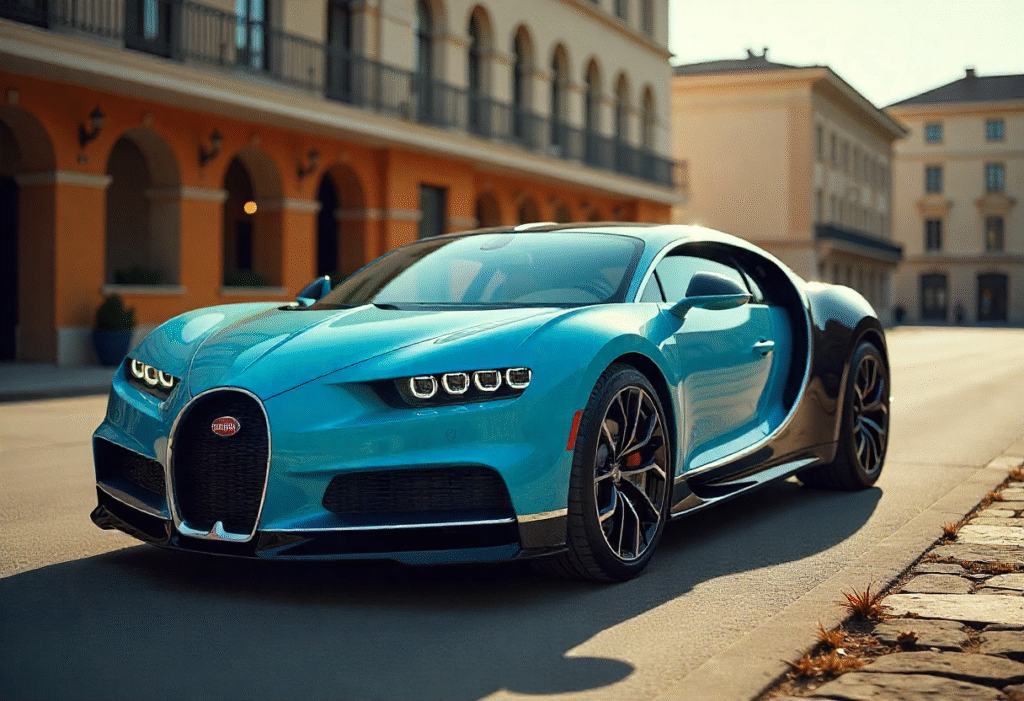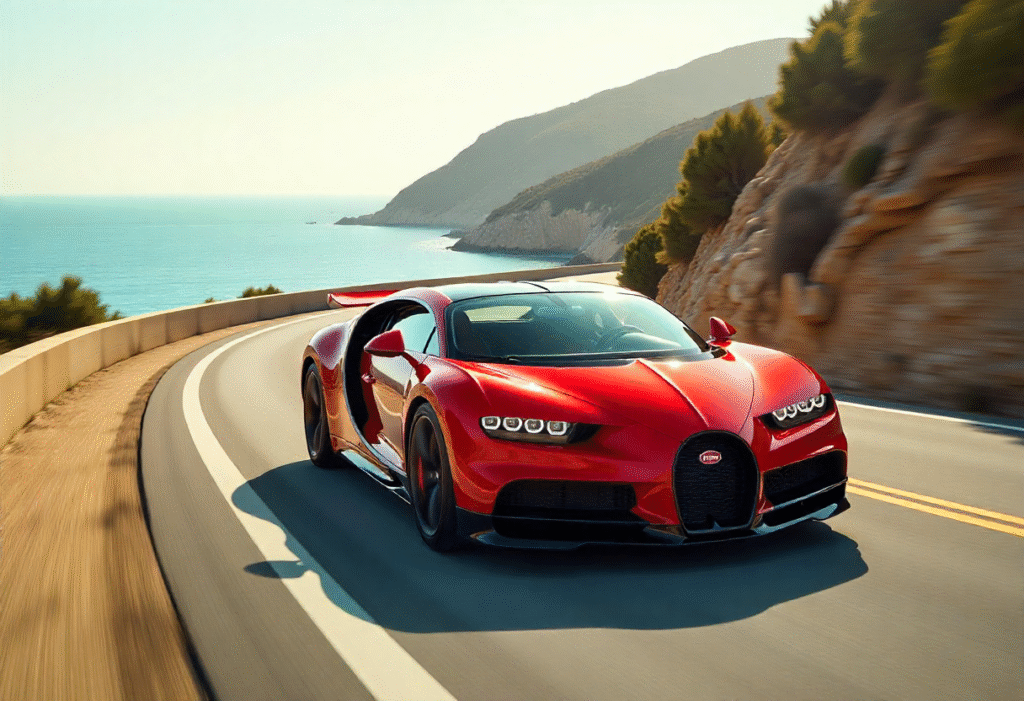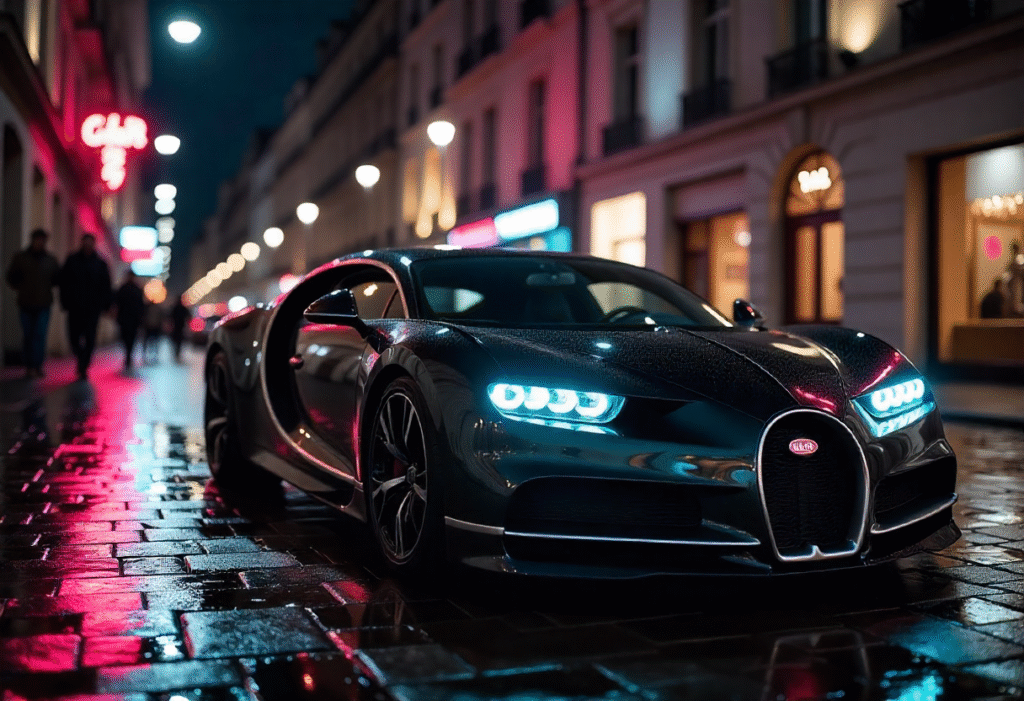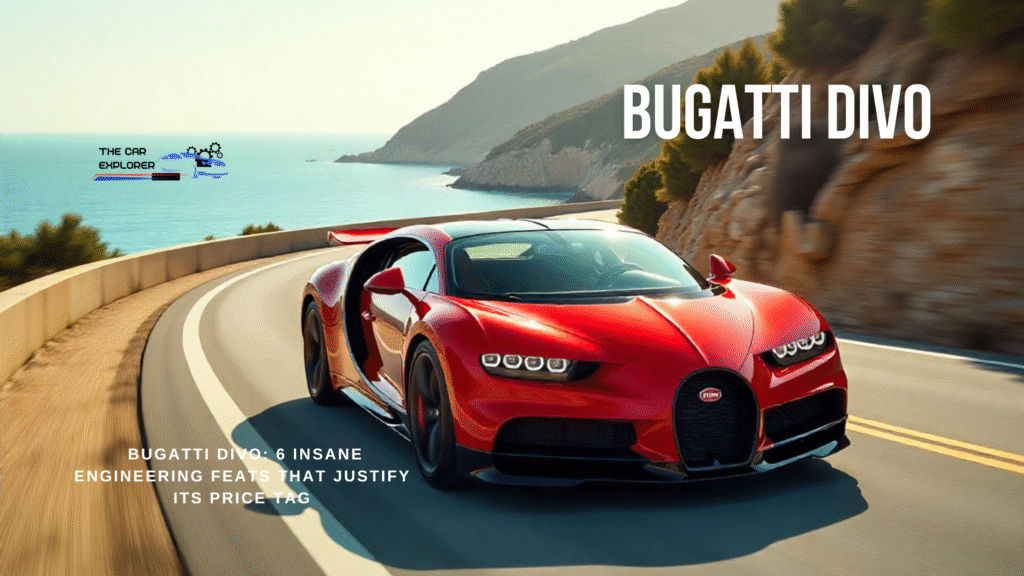Table of Contents
Introduction: Why the Bugatti Divo Is Worth Every Million
It is normal to say why when you hear that a certain car costs more than $5.8 million. The solution, with the Bugatti Divo, is in its excesses indeed, but in its engineering that is beyond the point of obsession.

It is not a regular hypercar. Although it is the grown-up companion to the already mythical Bugatti Chiron, the Divo is a completely different animal. While the Chiron has been designed to run straight and fast and look smashing on any grand tour, the Bugatti Divo has been tailored to attack the bends as a weapon of reduced weight, improved aerodynamics, and better handling than its big brother. On the negative side, it is the most sluggish car here when using its lowest available speed (236 mph), but this is because it is extremely agile, with plenty of downforce and extreme driver involvement to handle.
However, the real reason that the Divo costs so much is the six new technological wonders which run through every line of its car- it has a high aerodynamic profile an unrivaled attention to detail, lightweight chassis. This automobile has nothing to do with flashing; it has everything to do with form and function in the most elitist way possible.
In the pages which follow, we are going to explore in detail with you each of the six insane innovations which make the Bugatti Divo more than an exclusive hypercar, which puts it on a different level entirely, and which is up to the standards of absolute exclusivity.
Aerodynamic Wizardry: Built to Slice Air Like a Blade
When it comes to hypercars, the speed is a language (or at least that is what it is supposed to sound like); however, aerodynamics is the grammar, and the Bugatti Divo knows how to talk the grammar of hypercars. In contrast to the Chiron that emphasizes a straight-line performance, the Divo is absolutely carefully designed to master the corners, in large part, due to its greatly augmented aerodynamic shape.
Central to this revolution is an active rear wing-broad, and more agile than what the Chiron has. It is not just a high-speed air brake, but it also changes its angle automatically according to the driving conditions to provide optimum downforce and stability. Combined with a race-style rear diffuser that is overly aggressive, it precision-cuts through the air with surgical precision and holds the Divo to the tarmac even at top speeds.
The bodywork is redesigned to enhance the flow of air. The front splitters are sharp, and the air intakes are widened, and the ventilation ducts are redesigned to work in harmony to control airflow over, under, and throughout the car. Even the roof has a special NACA duct which draws the cool air straight into the huge W16 engine–without excessive drag.
However, the most surprising figure is probably the following: the Bugatti Divo produces 198 lbs (90 kg) of additional downforce compared to the Chiron. That is a step that totally changes the character of the car on sharp, high-velocity cornering. An extra amount of downforce translates into an increased amount of grip, and the increased amount of grip translates into increased confidence at the bound of physics.
It is not purely aesthetic design (although there is some of that, of course), not a design just to be designed: in the Bugatti Divo every curve, every fin, every slit, has been designed to enhance high-velocity stability, effectiveness in cooling, and cornering. It is one of those city-driving bombshell masterclasses in aerodynamic wizardry and one of the main reasons why the Divo stands in a league of its own.
Precision-Tuned Chassis: Track-Optimized for Hyper Agility
Although the other hypercars can boast of nothing more than sheer speed, the Bugatti Divo takes it further and redefines what agility is in a car of such a caliber. Designed to master technical tracks and mountain mortise, the Divo has a perfectly tuned chassis that allows razor-sharp handling that few cars on the planet can replicate.
It has been re-engineered by a superior suspension system in which cornering dynamics are the core objective. Stiffer dampers, stiffer springs, and yanked-back calibration of the camber angles endow the Divo with the responsiveness and road feel that, quite honestly, just does not exist in the more comfortable world of the Chiron. The driving experience is more responsive and faster as the steering provides the driver with a faster and closer response, with increased confidence when driving aggressively.
What is even more surprising is the fact that Divo seemed to have a weight advantage. Due to materials and design choices made to enhance performance, the Bugatti Divo is about 77 lbs (35 kg) lighter than the Chiron. That may not seem like much on paper, but in the subset of hypercar engineering, that loss of mass can have a drastic impact on how quickly a car turns in, the quickness of the brake response, and the balance of the chassis.
The result? A vehicle that just won’t let go of the asphalt, a vehicle that holds on endlessly- either echelon of hairpins or on the limit between taming and loss of control on a personal track. Even in a straight line, the Bugatti Divo is fast, but it becomes an actual predator on the corners because of its custom handling calibration.
In an industry in which swiftness is the norm, it is the extreme latent dexterity and precision-like maneuverability of the Divo that renders it most distinctive, as well as a more than justifiable price.
W16 Powerhouse: A Mechanical Masterpiece with 1,479 HP
The Bugatti Divo is also a masterpiece at heart, literally because its heart is the legendary 16-cylinder engine, the Bugatti 8.0-liter quad-turbo W16. Not only is this a piece of mechanical wizardry right in the very center of the Divo, a par, which also serves as an illustration of the relentlessness approach to engineering at Bugatti.
This engine generates a mind-dropping of 1,479 horsepower and 1,180 lb-ft of torque, making the Divo reach a top speed of 0 to 60 miles per hour in only 2.4 seconds. However, numbers cannot be the only information. The nicest thing about this powertrain is that it is easy to deliver the performance at any range of revs. The W16 is just viciously torque-laden, whether you are pressing down a straight or ripping out of a turn, that buttery deliciousness.

Naturally, such a powerful engine produces titanic amounts of heat, but that is where Bugatti’s genius engineers really excelled. The Bugatti Divo has a state-of-the-art cooling design boosted by ten separate radiators, the most optimal airflow system, and active thermal management. All the vents, scoops, and ducts on the car are used to purge the engine, brakes, transmission, and intercoolers of heat.
The Divo does not sweat, even at its most extreme speeds or even at its most stressed on the track: There is a thermodynamic plan of attack nearly worthy of aerospace sophistication. It implies that we can enjoy continued power without worrying about the effects of overheating, which is unique to a car with almost 1500 horsepower.
With the vehicle, Bugatti Divo arrives in this era of electrification as a subversive, magnificent liberation of combustion engines, a union of power and precision. It is not an engine, it is a living, breathing feature that makes every thin penny of the astronomical price of the Divo worth the price.
Ultra-Lightweight Construction: Every Gram Counts
Weight is not a consideration when you are designing a hypercar such as the Bugatti Divo; it is an obsession. Each gram saved is something that can be applied to sharper handling, accelerating faster, and day-to-day control. That is why, in the making of the Divo, Bugatti treated the project to be an aerospace project.
The Bugatti Divo body is indescribably made out of carbon fiber, including the smooth aerodynamic panels, the complexly designed rear diffuser, and the active rear wing. This not only helps in weight reduction but also in maximizing rigidity, enabling the chassis to be as enduringly stable at high speeds and when a lateral force is applied.
However, that is not all that Bugatti did. Even the wheels are made of magnesium, reducing a lot of weight compared to the ones using conventional aluminum, and still maintaining the structural rigidity. Such important parts as bolts, exhaust parts, even some interior trim pieces are of titanium- a material that would be used on a fighter jet and not a luxury car.
In the cabin, the philosophy continues. The weight of ultra-thin carbon fiber bucket seats, a minimalistic and laser-cut lightweight upholstery of Alcantara materials, and an exclusive but race-ready sensation just got rid of every sultry ounce.
The result? There is a very important achievement when the Bugatti Divo weighs 77 pounds (35 kg) less in a car that is already made of high-performance materials everywhere. And although it may not come out as dramatic, it has an immense effect in making the car a lot more agile, brake faster, and increase the dynamics of the car to drive.
The Bugatti Divo, in a world of hypercars where weight always seems to accompany the price of luxury, moves in the opposite direction – a car that laps like a track car with its lack of weight savings is simply clever and fanatical. It is not only lighter, but smarter.
Bespoke Craftsmanship: Engineering Meets Haute Couture
The Bugatti Divo is not only an automobile that can perform as a piece of art; it is also a car that was crafted to be a masterpiece. There is nothing brutal about the track capability of this machine; behind it is an artistry that goes toe-to-toe with the best fashion houses and luxury ateliers in the world. Each Divo is hand-assembled, completely bespoke, and made to incorporate the personal ideas of a buyer.
The level of craftsmanship in the Bugatti atelier in Molsheim, France, is obsessive. The clients work side-by-side with the design staff of Bugatti in choosing the bespoke materials, color schemes, and sets of trim forms. As meticulous as the stitching on the seats to the surface of the well-known center console, no two Bugatti Divos are ever going to be the same.
What awaits inside is laser-cut leather, monograms stitched perfectly, and even 3D-printed titanium details; elements creating the perfect mix of the modern and the classic. It is not just luxurious materials: they can do their functions. The heaviest materials have been eliminated in favor of lightweight Alcantara, so that lightweight considerations have been applied to every design.
Nevertheless, the Bugatti Divo is not oriented towards speed and precision at the expense of driver comfort. The cabin has been equipped with sound-proofing of a high level, climate control according to the airflow through the cabin, and seats that are ergonomically oriented towards long-distance high-performance travel. It is a functional cockpit in an elegant dressing.
This perfect compromise between custom design and race-ready would give the Divo an edge over any other Bugatti. It is not merely put together; it is modeled, stippled, and completed like a piece of automotive haute couture that you actually can wear.
To people who insist on uniqueness without any concessions, the Bugatti Divo is a driving museum of technical and luxurious perfection in a single, uncompromised message.
Heat Management & Stability at Extreme Speeds

When driving beyond 236 mph, all systems of a hyper car are on the verge of breaking but not only in terms of sports performance, but also heat. This is why one will find some of the most sophisticated thermal management and stability systems that have ever been created in an automotive system, in the Bugatti Divo.
Engine Bay Airflow: Cooled by Design
The quad-turbocharged W16 engine in the Divo is a particularly large one and very hot to run, so the car is sleekly designed to equate every inch of the square body to accommodating the heat. A strategically designed set of air inlets, NACA ducts, and high efficiency heat exchangers make sure that all the vital parts of the car remain within allowable temperatures, even under long periods of full speed driving, or track operation.
The engine cooling works on its own system of surgical routing of air through the engine bay, cross-radiators, and out the rear diffuser to produce a continuous cooling loop and maintain temperatures at a constant level without adding drag.
Brake and Tire Cooling: No Weak Links
Bugatti Divo has large ceramic carbon brakes that are not only used to stop hard, but to allow high-load repetition too. Ducting airflow with brake coolers built into the frame, these brakes never fade regardless of whether you are decelerating off 200 miles an hour or ripping a hairpin.
The tires are also thermally controlled in that air is being blown strategically towards the tires to maintain the maximum temperature of the tires. Such attention to detail implies better grip, long life, and above all, safety at previously unimaginable speeds.
Hyper-Stable at Hypersonic Speeds
Being lighter and track-focused, the Bugatti Divo is still a remarkably stable car at its full blast. These enhanced downforce, a reduced center of gravity, and intelligent suspension tuning combine with materials particular in resisting the accompanying and controlling any heat, to provide rock-solid control even over surfaces that are not smooth or those that are fast.
The aerodynamic mechanisms do not just make the car stick on the road, but also help in maintaining the thermal regulator and balancing the direction, giving the Divo a surgical feel even as it is breaking a hole in the air at supercar-defying speed.
In other words, the Bugatti Divo does not merely survive up to 236 mph; instead, of thrives up there despite its obsessive engineering, which sees to it that the car remains calm, collected, and completely in control.
Conclusion: The Bugatti Divo Isn’t Just Expensive—It’s Exceptional
With the world chock-full of luxury-badged rapid transport, the Bugatti Divo is not a competitor, but is something above and beyond. Each finer, including its brutal aerodynamics, hand-made interior, is constructed not only to impress, but to redefine the laws of auto engineering. This is not the car that will be rotating in valet stands; this is the car that is track-oriented with precise tuning and worth a million dollars.
The price tag of the Divo is not really what makes it special; it is the ingenuity that it took to design it. Light, sharp, rare, and driver-friendly compared to the Chiron, the Bugatti Divo is a product of the realization that insanely brutal performance requires insanely crazy detail work. And when that aspect comes back to bear in terms of history-making speed, handling, and exclusivity, the price is not just worth it, but even awaited.
To the fortunate few who are able to possess a Divo, it is not a car. It is a juicy collector-grade piece of engineering, and most likely, the epitome of the combustion age of automobile design.
For more info: Click Here.
FAQs
What is the quantity of the manufactured Bugatti Divo?
It was also the Bugatti Divo, which did not become an exception since only 40 copies of the car were sold in the whole world. All these were being designed with the preferences of their owners in mind.
Is Chiron slower or slower than Bugatti Divo?
Not at the highest speed. The Bugatti Divo has a limit of 236 mph, and the capacity of Chiron has exceeded 261 mph. However, the Divo is so much quicker when switched to technical tracks and wavy roads because it manages more and generates more downforce.
Why is the Bugatti Divo more costly than the Chiron?
As one can see, the price of Divo indicates success in aerodynamics, the reduction in weight, handcrafted work, and track performance. It is more restricted and less extensive machine a machine made not merely to be rare but also a work of engineering genius to the connoisseur.



